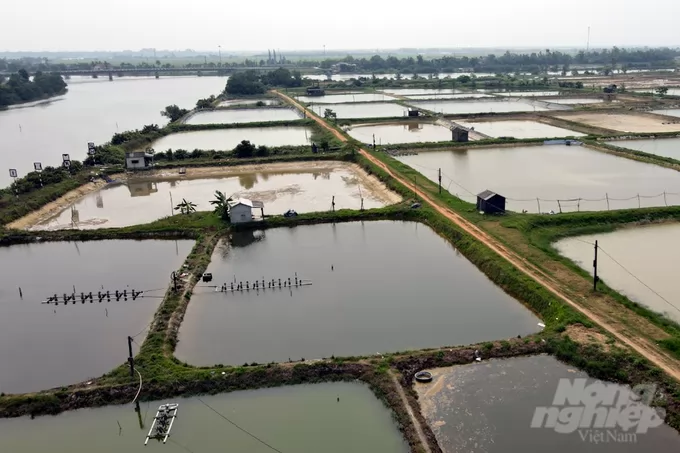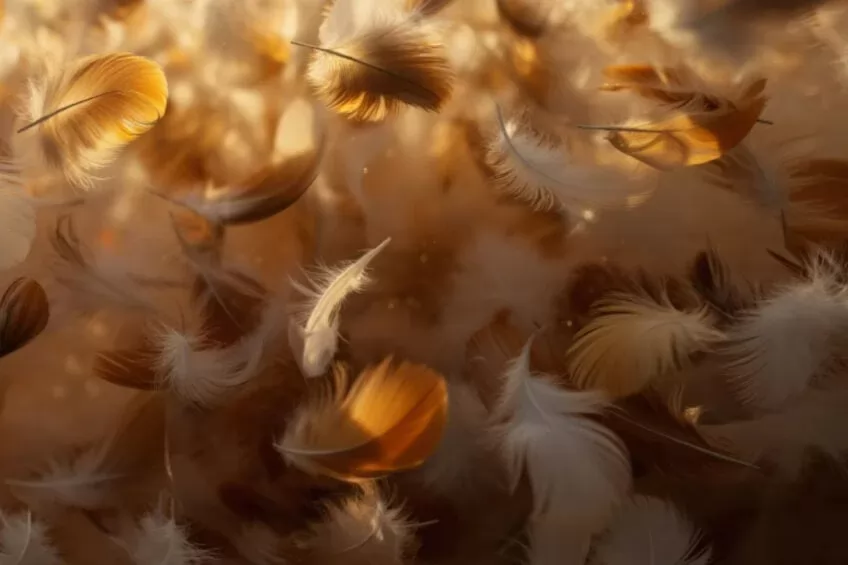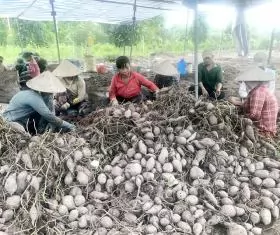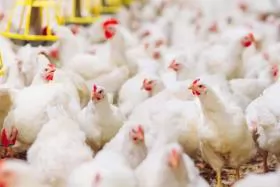High-tech and climate resilience shrimp farming

Traditional shrimp farmers along the Sa Lung River have faced significant losses due to environmental ichallenges. Photo: Vo Dung.
(VAN) High-tech shrimp farming continues to grow, whereas traditional shrimp farmers suffer losses due to climate change and environmental pollution.
In 2023, Cao Thi Thuy, a resident of Quang Xa Village, Vinh Lam Commune, Vinh Linh District, received support from the Quang Tri Province's Agricultural Extension Center to develop an intensive two-stage whiteleg shrimp farming model. Accordingly, she received instructions to use only 0.3 out of the total 1 hectare for shrimp breeding and farming. The remaining space was designated for water storage and treatment. After nearly four months of farming, her family harvested over 12 tons of commercial shrimp, yielding approximately 30 tons per hectare and generating a profit of over 700 million VND.
During the implementation process, Thuy reared the shrimp in a nursery pond at a density of 500 shrimp per square meter. When the shrimp reached a size of 150 to 170 shrimp per kilogram after approximately 1.5 months, she transferred them to a grow-out pond at a density of 150 to 160 shrimp per square meter. After three months, the shrimp reach a size of 38 shrimp per kilogram, allowing Thuy to thin out the population to reduce density, then continue farming for another month until they reach a size of 26 shrimp per kilogram, at which point they are available for harvest.
Thuy remarked that the two-stage whiteleg shrimp farming process offers a wide range of advantages: "The large water storage area facilitates thorough treated of the water that enters the nursery and grow-out ponds, thereby minimizing harmful pathogens. This farming process simplifies disease management efforts and allows the shrimp to reach larger sizes."
The concentrated shrimp farming area at Quang Xa Cooperative in Vinh Lam Commune spans over 23 hectares, with approximately 10 hectares dedicated to high-tech shrimp farming following a two- or three-stage process. Additionally, the cooperative equips all of its farming ponds with roofing systems. According to local shrimp farmers, a covered above-ground pond with an area of 800 to 1,000 square meters costs between 300 and 400 million VND. Consequently, the two-stage shrimp farming process is an ideal solution that helps farmers mitigate the adverse effects of weather and water conditions and regulate temperatures, especially during hot summer months or seasonal transitions.

High-tech shrimp farming continues to develop exponentially. Photo: Vo Dung.
Hoang Duc Huan, leader of the shrimp farming group at Quang Xa Cooperative, reported that high-tech shrimp farming has seen significant growth within the cooperative over the last two years. Accordingly, the cooperative's shrimp harvest output reached over 93 tons in 2023, generating a total revenue of approximately 16.5 billion VND; after deducting costs, the profit amounted to nearly 8 billion VND. Notably, the majority of traditional intensive shrimp farming households have suffered heavy losses due to the pollution in the Sa Lung River. Conversely, shrimp farmers employing high technology and the two- to three-stage process have enjoyed relative success.
Following its implementation in 2018, Quang Tri Province has developed over 100 hectares of high-tech shrimp farming area, primarily located in the districts of Hai Lang, Trieu Phong, Gio Linh, Vinh Linh, and Dong Ha City. The majority of high-tech shrimp farming models have yielded successful results and high economic returns for farmers by mitigating disease risks and reducing production costs.
Nguyen Huu Vinh, Deputy Director of the Quang Tri Province's Department of Agriculture and Rural Development, reported that the province currently houses nearly 3,400 hectares of aquaculture production area, with an annual output ranging from 7,500 to 10,000 tons. However, the majority of local operations employ traditional practices, which carry high risks.
High-tech shrimp farming addresses issues related to diseases and environmental conditions, particularly in terms of waste management and the treatment of toxic gases commonly encountered in traditional farming practices. Notably, sixty-day-old shrimp tend to produce a significant amount of waste at the bottom of the ponds, facilitating the emergence of toxic gases that can affect water quality and the health of the shrimp.

Two-stage shrimp farming enables farmers to proactively manage diseases and adapt to climate change. Photo: Vo Dung.
The transition from nursery ponds to grow-out ponds allows farmers to maintain the bottom of the grow-out ponds, which can result in shorter farming cycles in each pond and minimal accumulation of waste and toxic gases. Additionally, the farming cycle for each pond lasts only two months. On the other hand, farmers rotate the grow-out ponds in a staggered manner, allowing them to increase the number of production cycles per year.
"The Quang Tri's agricultural sector has developed and promoted various high-tech shrimp farming models in recent years, including a multi-stage farming process, biofloc technology, and VietGAP standards. High-tech shrimp farming is a suitable approach in response to climate change and environmental pollution," stated Deputy Director Nguyen Huu Vinh.
Author: Vo Dung
Translated by Nguyen Hai Long
Maybe you are interested

Scientists develop technology for converting feathers into feed-grade meal
A group of Iranian scientists from the National Institute of Genetic Engineering and Biotechnology claimed that they have developed a technology that allows effective processing of poultry feathers into meal using a Bacillus strain.

Mekong Delta authorities seek to boost farm produce sales amid transport restrictions
HCM CITY - Authorities in the Cửu Long (Mekong) Delta are taking measures to boost the sales of agricultural products as travel restrictions to prevent the spread of COVID-19 affect them.

Russia to ban free-range poultry
'The new rules prohibiting free range make organic production impossible,' the Union said.





